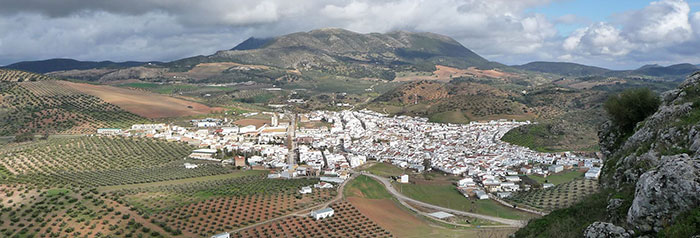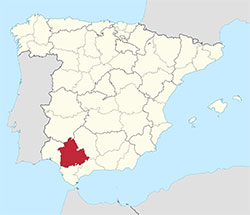Seville in Seville

Seville is the largest of Andalucía’s eight provinces, both in relation to surface area and population size, although it is not the most densely populated – it is number three in Andalucía after Málaga and Cádiz. The province covers 14,042 km2 and counts some 1.95 million inhabitants. The province of Seville borders on the region of Extremadura, and on fellow Andalucían provinces Córdoba, Málaga, Cádiz and Huelva.
 The highest point in Seville is the Terril peak in the Sierra del Tablón in the south of the province. It reaches a height of 1,129 MASL. Seville is the leading province for agriculture in Andalucía. It is the number one producer of many cereals and pulses as well as oranges, peaches and eating grapes. Also, it has the highest number of livestock within the equine, porcine and goat industries and is high on the list for other types of livestock.
The highest point in Seville is the Terril peak in the Sierra del Tablón in the south of the province. It reaches a height of 1,129 MASL. Seville is the leading province for agriculture in Andalucía. It is the number one producer of many cereals and pulses as well as oranges, peaches and eating grapes. Also, it has the highest number of livestock within the equine, porcine and goat industries and is high on the list for other types of livestock.
The capital of Seville – Seville – is considered one of the most beautiful cities in Spain, and it attracts almost all the attention and all the visitors. Nevertheless, there are many other places to visit in the province, which boasts archaeological digs, medieval castles, amazing nature sites and beautiful, traditional villages.
The city of Seville is not only the capital of the province of the same name – it is the capital of all of Andalucía, and where the Junta de Andalucía resides. The city is home to 688,592 souls, who are referred to as ‘sevillanos’ or ‘sevillanas’. However, they are also known as ‘hispalenses’. This is due to the fact that Seville, which was one of the most important cities in the Roman Empire, was known by the Romans as Hispalis, and the place adjective hispalense has stuck.
Seville is Spain’s fourth most populated city, only exceeded by Madrid, Barcelona, and Valencia. It is also Spain’s third most visited capital city after Barcelona and Madrid. Its old centre covers 3.9 km2 and is the most extensive one in Spain, and the sixths largest in Europe. Seville is also home to one of the largest historic centres in Spain. (The difference between old and historic centre is that ‘old centre’ covers the period up until the Industrial Revolution, and ‘historic centre’ refers to later periods.)
The Guadalquivir, Spain’s only navigable river, runs through the city, and in fact Seville is home to Europe’s largest commercial port which is not a sea port! Ever since Seville was known as Hispalis, the city has used the river for transporting goods, and although the size of today’s ships makes it impossible for many of them to reach the city, the river is still a major highway for transporting commercial goods along the 70 km to the sea.
Of course, the Guadalquivir also provides a popular way for tourists to see Seville from a different angle, in the sightseeing barges that travel up and down the river. Seville’s Easter Processions are some of the most passionate and famous in all of Spain, and it will not come as a surprise that they were declared of International Tourist Interest in 1980; they date back to the 16th century, and nowadays they count no less than 71 different ‘brotherhoods’, each with their own float, procession and following.
Another famous annual event in Seville is the April fair (Feria de Abril), which is a festival of flamenco music and dance, tapas and drink, beautiful women and handsome men in traditional costume mounted on stunning horses. The city is also home to a large array of famous monuments – the most emblematic of which is probably the Giralda tower, part of the cathedral, which is visited by close to two million tourists a year. With its height of 97.5 metres, it is not the city’s tallest tower, but it has had enough impact on foreign visitors over the years for there to be Giralda-inspired towers in Puerto Rico, in Habana in Cuba and in Kansas in the USA.
The Plaza de España offers an amazing mix of architecture and water features; the Alcázar castle complex, built by the Moors, is a stunning castle/ fortress with beautiful gardens and impressive Moorish architectural details; the cathedral, which has been the setting of countless weddings of royals, aristocrats, and celebrities over the centuries – all of them are a must on the visitor’s itinerary.
Seville is home to more than 25,000 orange trees, which can be found all over the city, notably in the Patio de los Naranjos, but also along the streets and in the squares and parks. The planting of orange trees in Seville started during the Moorish occupation of the city; according to Eastern tradition, orange trees bring happiness to their owners. And the scent in the streets of Seville during the orange blossom season is a true joy to breathe in.
The climate of Seville is very hot in summer, and in these days of global warning it is not unusual for the daytime maximum temperature to rise to, or even above, 40ºC. The winters are mild and the wettest of the seasons. The average annual rainfall of about 500 litres/m2 falls mainly between October and April.


